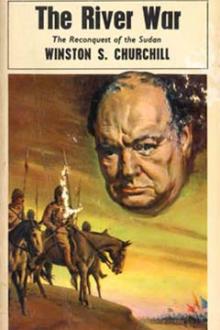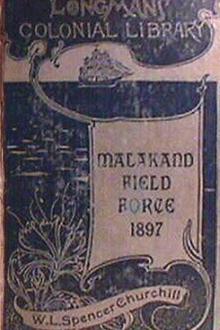The River War by Winston Churchill (spiritual books to read txt) 📕

- Author: Winston Churchill
- Performer: -
Book online «The River War by Winston Churchill (spiritual books to read txt) 📕». Author Winston Churchill
It was, indeed, a time of sore trouble. To find the servant dead in the camp kitchen; to catch a hurried glimpse of blanketed shapes hustled quickly to the desert on a stretcher; to hold the lantern over the grave into which a friend or comrade—alive and well six hours before—was hastily lowered, even though it was still night; and through it all to work incessantly at pressure in the solid, roaring heat, with a mind ever on the watch for the earliest of the fatal symptoms and a thirst that could only be quenched by drinking of the deadly and contaminated Nile: all these things combined to produce an experience which those who endured are unwilling to remember, but unlikely to forget. One by one some of the best of the field army and the communication Staff were stricken down.
Gallant Fenwick, of whom they used to say that he was ‘twice a V.C. without a gazette’; Polwhele, the railway subaltern, whose strange knowledge of the Egyptian soldiers had won their stranger love; Trask, an heroic doctor, indifferent alike to pestilence or bullets; Mr. Vallom, the chief superintendent of engines at Halfa; Farmer, a young officer already on his fourth campaign; Mr. Nicholson, the London engineer; long, quaint, kind-hearted ‘Roddy’ Owen—all filled graves in Halfa cemetery or at the foot of Firket mountain. At length the epidemic was stamped out, and by the middle of August it had practically ceased to be a serious danger.
But the necessity of enforcing quarantine and other precautions had hampered movement up and down the line of communications, and so delayed the progress of the preparations for an advance.
Other unexpected hindrances arose. Sir H. Kitchener had clearly recognised that the railway, equipped as it then was, would be at the best a doubtful means for the continual supply of a large force many miles ahead of it.
He therefore organised an auxiliary boat service and passed gyassas and nuggurs [native sailing craft] freely up the Second Cataract. During the summer months, in the Soudan, a strong north wind prevails, which not only drives the sailing-boats up against the stream—sometimes at the rate of twenty miles a day—but also gratefully cools the air. This year, for forty consecutive days, at the critical period of the campaign, the wind blew hot and adverse from the south. The whole auxiliary boat service was thus practically arrested. But in spite of these aggravating obstacles the preparations for the advance were forced onwards, and it soon became necessary for the gunboats and steamers to be brought on to the upper reach of the river.
The Second Cataract has a total descent of sixty feet, and is about nine miles long. For this distance the Nile flows down a rugged stairway formed by successive ledges of black granite. The flood river deeply submerges these steps, and rushes along above them with tremendous force, but with a smooth though swirling surface. As the Nile subsides, the steps begin to show, until the river tumbles violently from ledge to ledge, its whole surface for miles churned to the white foam of broken water, and thickly studded with black rocks. At the Second Cataract, moreover, the only deep channel of the Nile is choked between narrow limits, and the stream struggles furiously between stern walls of rock. These dark gorges present many perils to the navigator. The most formidable, the Bab-el-Kebir, is only thirty-five feet wide. The river here takes a plunge of ten feet in seventy yards, and drops five feet at a single bound.
An extensive pool above, formed by the junction of two arms of the river, increases the volume of the water and the force of the stream, so that the ‘Gate’ constitutes an obstacle of difficulty and danger which might well have been considered insurmountable.
It had been expected that in the beginning of July enough water would be passing down the Second Cataract to enable the gunboats and steamers waiting below to make the passage. Everything depended upon the rise of the river, and in the perversity of circumstances the river this year rose much later and slower than usual. By the middle of August, however, the attempt appeared possible. On the 14th the first gunboat, the Metemma, approached the Cataract. The North Staffordshire Regiment from Gemai, and the 6th and 7th Egyptian Battalions from Kosheh, marched to the ‘Gate’ to draw the vessel bodily up in spite of the current. The best native pilots had been procured. Colonel Hunter and the naval officers under Commander Colville directed the work. The boat had been carefully prepared for the ordeal.
To reduce, by raising the free-board, the risk of swamping, the bows were heightened and strengthened, and stout wooden bulwarks were built running from bow to stern. Guns and ammunition were then removed, and the vessel lightened by every possible means. A strop of wire rope was passed completely round the hull, and to this strong belt the five cables were fastened—two on each side and one at the bow. So steep was the slope of the water that it was found necessary to draw all the fires, and the steamer was thus dependent entirely upon external force. It was luckily possible to obtain a direct pull, for a crag of black rock rose above the surface of the pool opposite the ‘Gate.’ On this a steel block was fixed, and the hawser was led away at right angles until it reached the east bank, where a smooth stretch of sand afforded a convenient place for the hauling parties. Two thousand men were then set to pull at the cables, yet such was the extraordinary force of the current that, although the actual distance in which these great efforts were necessary was scarcely one hundred yards, the passage of each steamer occupied an hour and a half, and required the most strenuous exertions of the soldiers. No accident, however, occurred, and the six other vessels accomplished the ascent on successive days.
In a week the whole flotilla steamed safely in the open water of the upper reach.
And now for a moment it seemed that the luck of the expedition had returned. The cholera was practically extinct. The new gunboat Zafir was nearly ready at Kosheh, and her imposing appearance delighted and impressed the army. On the 23rd of August all the seven steamers which had passed the Cataract arrived in a stately procession opposite the camp.
Almost at the same time the wind changed to the north, and a cool and delicious breeze refreshed the weary men and bore southward to Suarda a whole fleet of sailing boats laden with supplies, which had been lying weather-bound during the previous six weeks at the head of the rapids.
The preparatory orders for the advance tinkled along the telegraph.
The North Staffordshire Regiment were, to the intense relief of officers and men, warned to hold themselves in readiness for an immediate move.
The mounted troops had already returned to the front from the camps in which they had been distributed. At last the miserable delay was over.
From Kosheh to Kerma, the first Dervish position, the distance by river is 127 miles. A study of the map shows that by land marches this can be shortened by nearly forty-one miles; thirty miles being saved by cutting across the great loop of the Nile from Kosheh to Sadin Fanti, and eleven miles by avoiding the angle from Fereig to Abu Fatmeh. From Kerma to Dongola, which latter town was the objective of the expedition, a further distance of thirty-five miles must be traversed, making a total of 120
miles by land or 161 by river. The long desert march from Kosheh to Sadin Fanti was the only natural difficulty by land. Although the river from Kosheh to Kerma is broken by continual rapids, it is, with one interval, freely navigable at half Nile. The Amara Cataract, ten miles beyond Kosheh, is easily ascended by sailing boats with a fair wind, and by steamers without assistance. From Amara to the Kaibar Cataract stretches a reach of sixty-five miles of open water. The Kaibar Cataract is, during the flood, scarcely any hindrance to navigation; but at Hannek, about thirty miles further on, the three miles of islands, rocks, rapids, and broken water which are called the Third Cataract are, except at high Nile, a formidable barrier, Once this is passed, there is open water for more than 200 miles at all seasons to Merawi. The banks of the river, except near Sadin Fanti, where the hills close in, are flat and low. The Eastern bank is lined with a fringe of palm-trees and a thin strip of cultivation, which constitutes what is called ‘the fertile province of Dongola.’
On the other side the desert reaches the water’s edge. Along the right bank of this part of the river the army was now to move.
The first act of the advance was the occupation of Absarat, and on the 23rd of August MacDonald’s brigade marched thither from Suarda, cutting across the desert to Sadin Fanti, and then following the bank of the Nile. The occupation of Absarat covered the next movement. On the 26th Lewis’s brigade was ordered to march across the loop from Kosheh to Sadin Fanti, and reinforce the brigade at Absarat. The distance of thirty-seven miles was far too great to be accomplished without a system of watering-places. This the Sirdar rapidly organised. Water-depots were formed by carrying tanks and water-skins on camels to two points in the desert, and replenishing them by daily convoys. But now a heavy calamity descended on the arrangements of the General and the hopes of the troops.
During the afternoon of the 25th the wind veered suddenly to the south, and thereupon a terrific storm of sand and rain, accompanied by thunder and lightning, burst over the whole of the Nubian desert, and swept along the line of communications from Suarda to Halfa. On the next day a second deluge delayed the march of Lewis’s brigade. But late on the 27th they started, with disastrous results. Before they had reached the first watering-place a third tempest, preceded by its choking sandstorm, overtook them. Nearly 300 men fell out during the early part of the night, and crawled and staggered back to Kosheh. Before the column reached Sadin Fanti 1,700 more sank exhausted to the ground. Out of one battalion 700 strong, only sixty men marched in. Nine deaths and eighty serious cases of prostration occurred, and the movement of the brigade from Kosheh to Absarat was grimly called ‘The Death March.’
The ‘Death March’ was the least of the misfortunes caused by the storms.
The violent rains produced floods such as had not been seen in the Soudan for fifty years. The water, pouring down the broad valleys, formed furious torrents in the narrower gorges. More than twelve miles of the railway was washed away. The rails were twisted and bent; the formation entirely destroyed. The telegraph wires were broken. The work of weeks was lost in a few hours. The advance was stopped as soon as it had been begun.
At the moment when every military reason demanded speed and suddenness, a hideous delay became inevitable.
In this time of crisis the success of the whole campaign hung in the balance. Sir Herbert Kitchener did not then possess that measure of the confidence and affection of his officers which his





Comments (0)